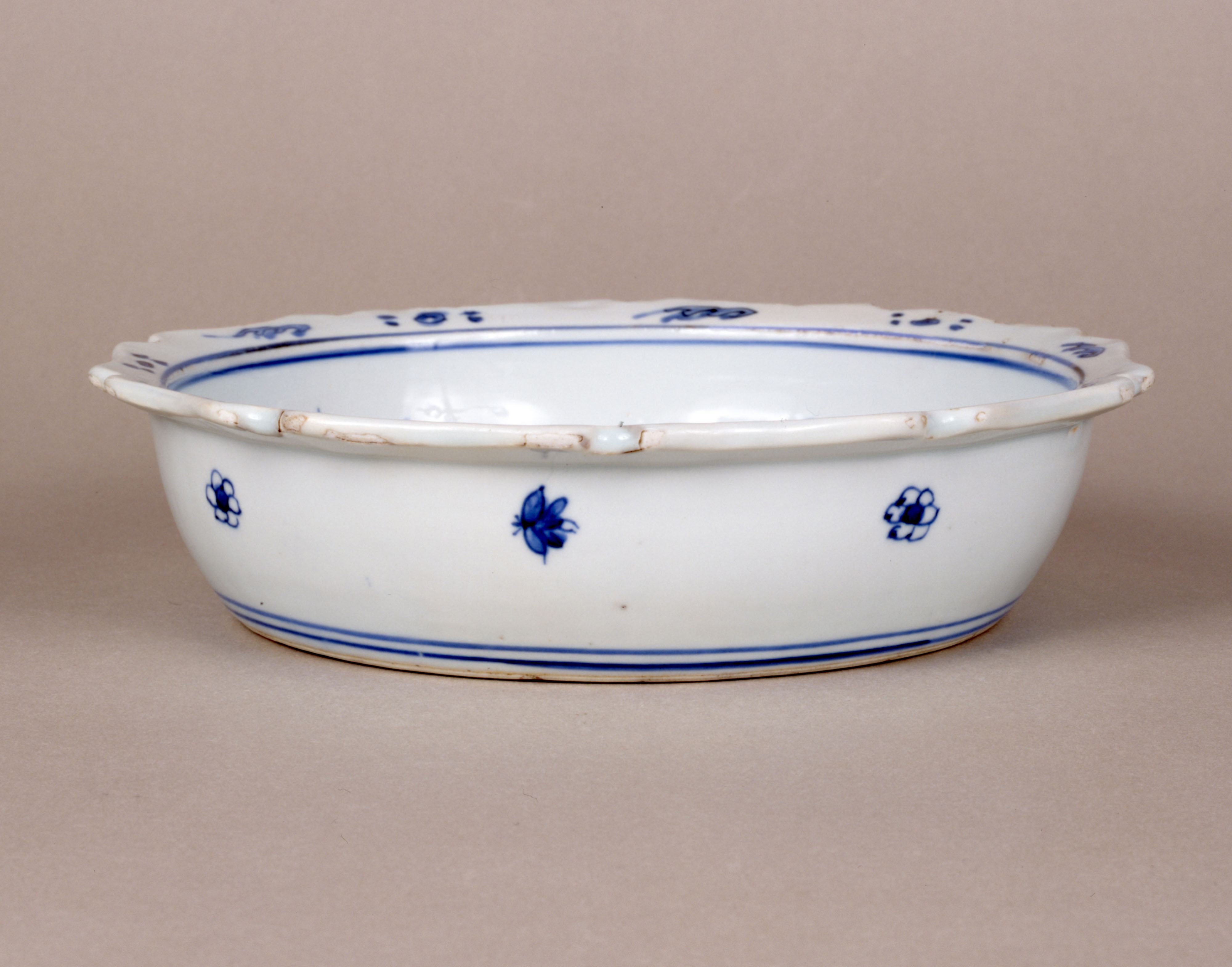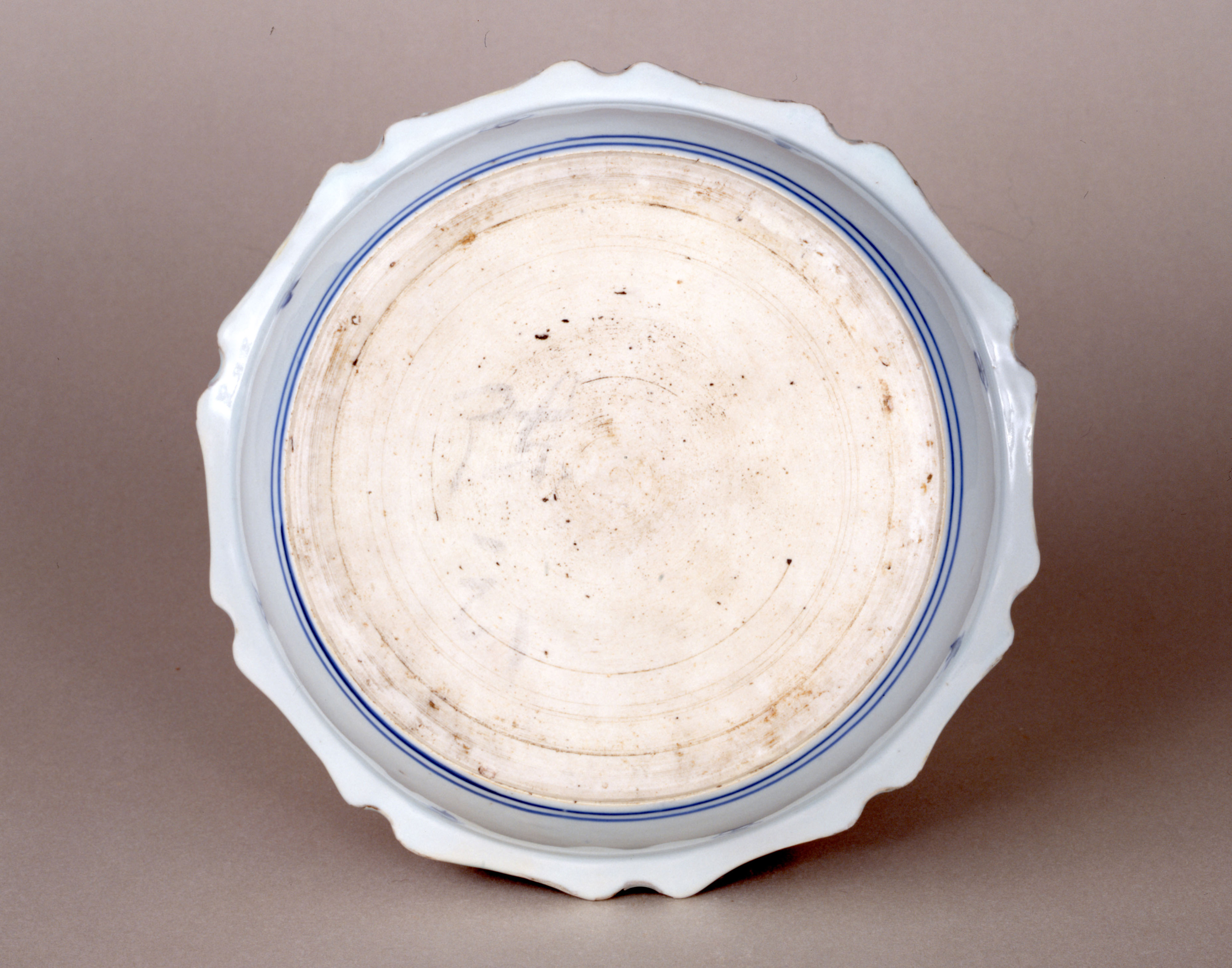
せいかがませんにんずりょうかばち 青花蝦蟇仙人図稜花鉢
17世紀(明 後)
「古染付」と呼ばれる明時代末期の景徳鎮窯で作られたやきものです。変則的な稜花の形をした口縁部を持つ銅鑼鉢で、内側には蝦蟇仙人らしき人物が紐に繋がった銭を持って3本足の蝦蟇と戯れる様子が描かれています。蝦蟇仙人とは、中国で言い伝えられる道士、劉海蟾(りゅうかいせん)と考えられています。劉海蟾の「蟾」が蟾蜍(せんじょ)(ヒキガエル)を意味することから蝦蟇と結びつき蝦蟇仙人とも呼ばれるようになったといわれています。明清時代には金運にご利益のある神様として人気が高まったこともあり、本作のように画題として描かれたのでしょう。古染付はその多くが日本に伝わっており、日本で特に好まれた中国のやきものです。
※稜花とは器の縁に規則的な切れ込みを入れた形です。
| 寸法 | 高5.5cm 口径22.3cm |
|---|---|
| 制作地 | 生産地域:中国/生産窯:江西省景徳鎮窯 |
| 寄贈者名 | 浦上敏朗 |

Flower vase, blue-and-white porcelain with a representation of the Toad Immortal
17th century
Blue-and-white porcelain produced at the Jingdezhen kilns in the late Ming period. This type of Jingdezhen ware is called “ko-sometsuke” (old blue-and-white ware) in Japan. This piece has an irregularly lobed brim. The inner surface is decorated with a scene in which a person who seems to be the Toad Immortal is playing with a three-legged toad, using a string of coins that leads up on his hand.It is said that the “chan” in Liu Hai-chan’s name means “toad”, which is connected to the word “toad” and thus the name “Toad Fairy”. It is believed that the Toad Immortal is Liu Haichan, a legendary Daoist in China. He was popular in the Ming and Qing periods as a divine who brought good fortune. It is thought that he was often portrayed as a motif on porcelain, as in this piece. A great deal of ko-sometsuke ware was imported into Japan because ko-sometsuke was a type of Chinese ware much favored in Japan.
* “Lobed brim” usually refers to a design in which the brim of a vessel is lobed in a regular pattern.
| Donor Name | Uragami Toshiro |
|---|

青花蝦蟇仙人圖菱花缽
這是日語稱“古染付”的,明朝末期景德鎮窯燒製的陶瓷器。銅鑼缽的口沿,呈不規則的菱花形狀,內側描繪著貌似蟾蜍仙人的人物,拿著係在繩子上的錢與3足金蟾嬉戲的樣子。所謂蟾蜍仙人,是指中國傳說中的道士劉海蟾。劉海蟾的“蟾”意為蟾蜍,所以與蟾蜍關聯,也被稱為海蟾仙人。明清時期,是人氣很高的財神,所以像這樣被描繪到器物上。古染付多數傳入日本,是在日本特別受歡迎的中國陶瓷器。
※菱花是指器皿邊緣規則的切口形狀。
| 捐贈者 | 浦上敏朗 |
|---|

청화 하마선인도 능화 발(청화자기. 두꺼비 신선도가 그려진 능화 모양의 그릇)
명나라 말기 경덕진요에서 만들어진 「고염부」라고 하는 도자기입니다. 그릇의 입 둘레가 변측적인 ‘능화’ 모양을 한 그릇으로, 안쪽에는 두꺼비 신선으로 보이는 인물이 엽전을 엮은 줄을 들고 다리가 세 개인 두꺼비와 장난을 치는 모습이 그려져 있습니다. 두꺼비 신선은 중국에서 돈을 풀어 빈자를 구제해 준다고 알려진 도사인 ‘유해섬’으로 보입니다. 유해섬의 한자를 보면, ‘섬’은 두꺼비 섬(蟾)으로, 두꺼비를 의미하는 것에서 두꺼비 신선으로 불리게 되었다고 합니다. 명청 시대에는 금전운에 이익을 주는 신으로서 인기를 끌었던 바, 본 작품과 같이 그림 소재로 쓰인 것으로 생각됩니다. 고염부 자기는 그 상당수가 일본에 들어왔으며, 일본에서 특히 인기가 많았던 중국 자기입니다.
※‘능화’는 그릇의 입 둘레를 꽃잎의 끝부분처럼 규칙적으로 베어내거나 들여 넣어 만든 형태를 말합니다.
| 기증자명 | 우라가미 토시로 |
|---|


